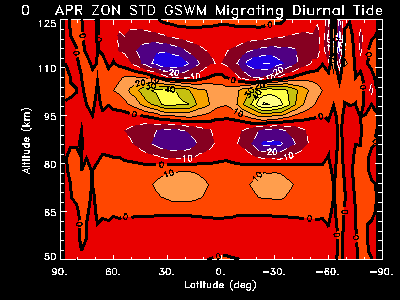
Animation cycles three times (three solar days). [ESC] to stop, Reload to replay.

Note the peak between 95-105km and the diminishing amplitude elsewhere (due to the denser atmosphere at lower altitudes, and gravity wave stress). Features near the poles result from noise in the solution of the tide, where it is weakly forced, rather than having physical significance.
The phase of the tide is the same across the equator, so the maxima at a given altitude in the northern and southern hemispheres occur in the same direction at the same time.
Contrast this with the peaks of the diurnal meridional tide, which are in opposite directions on either side of the equator, in either an altitude vs. latitude cross-section (January case) , or a latitude vs. longitude "top view" at 100km (April). This plot also shows the restriction of the diurnal tide to equatorial regions.
The consistent phase across the equator also appears in the semidiurnal plot of the zonal tide (April), whose peaks are spaced out away from the equator and closer to the poles.